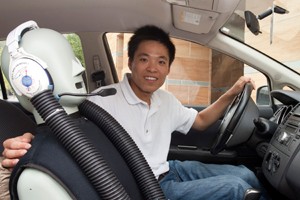
UC Research Promises Quiet Cars Even When Hitting Unexpected Bumps in the Road
All noise is not necessarily equal especially when it comes to sound minimization in automobiles.
For instance, automakers have long used sound-absorbing materials (passive control) in the design of cars in order to minimize engine noise and the routine noise of tires traveling on smooth pavement at a consistent speed. However, a means to minimize sudden, unexpected noises like those from an encounter with potholes, bumps or other roadway pavement obstacles has been more problematic.
A significant step in countering such unexpected roadway noises is the development of an adaptive, active algorithm that would enable the deployment of a rapid-response sound wave that would counter and, in effect, significantly erase the perceived road noise heard within the cars cabin when the auto unexpectedly hits a roadway obstacle like a pothole or bump. This development will be presented by University of Cincinnati engineering doctoral student Guohua Sun at the Aug. 19-22 INTER-NOISE, the 41st International Congress and Exposition on Noise Control Engineering.
His paper is titled Modified Filtered-x LMS Algorithm for Active Control of Vehicle Road Impact Noise, and co-authors are Mingfeng Li, research associate in UCs College of Engineering and Applied Science (CEAS), and Teik C. Lim, Herman Schneider professor of mechanical engineering.
According to Sun, Its expected that the numerical simulation, when tested in the real world, will reduce road-impact noise perceived by the car driver by three to five decibels. (That level of reduction is significant, minimizing the resulting sound by at least half to three quarters of its original volume.)
THE BASICS OF ACTIVE NOISE CONTROL
An active noise control (ANC) system like the mathematical simulation created by the UC team is fundamentally based on the active minimization of one sound wave (noise caused by a roadway obstacle) by an opposite-phased mirror wave. In other words, noise is heard due to the travel of sound waves. However, any particular noise can be quieted if its sound wave encounters an inverted mirror, opposite-phase sound wave. The two waves would overlap; however, while one wave is peaking, the corresponding out-of-phase wave dips. The end result is sound that is significantly diminished.
THE CHALLENGES OF ACTIVE NOISE CONTROL
Such active noise control in automobiles is available in high-end, luxury cars; however, even these ANC systems are used only to negate routine roadway noise the noise of a car traveling at a consistent speed on smooth pavement.
There is a real challenge in creating an ANC system that can treat random road noise, the impact sound of a pothole or a bump and other transient responses, such that the sound is minimized within the cars cabin. The challenge comes because the sound is unexpected and cannot be easily predicted. So, you need a stable, robust algorithm that can efficiently and quickly track such noise and respond to it, said Sun.

car and potholes
He added that the challenge is heightened by the fact that the sound must be minimized within the relatively large space of a cars cabin: ANC is whats used to dampen unwanted sounds when you put in music plugs into your ears, but thats a much easier problem to solve because your ear canal is a very small cavity.
CHANGES TO CARS THAT MAKE ACTIVE NOISE CONTROL ADVANCES POSSIBLE
The ANC algorithm created by Sun and his colleagues and advisor is applicable because of the electronic and digital systems now common in cars. For instance, the cars computer that operates music, GPS, engine sensor and other functions can also be employed to operate an ANC system, and the sensors (and even door and roof music speakers) now common in various parts of an automobile could be employed to generate ANC signals as needed.
LIKELY DEMAND FOR ACTIVE NOISE CONTROL
Sun expects that demand for active noise control features will increase as electric vehicles become more prevalent. Thats because an electric motor generates very little noise when compared to the engines found in traditional, gas-powered vehicles. Thus, an electric cars engine noise cannot mask ambient road noises as well as do more-traditional engines, and so, those road/ambient noises seem louder in an electric vehicle.
Or, conversely, an ANC system in an electric vehicle could be used to generate and mimic the sound of a traditional car engine.
Said Sun, Consumers might prefer an electric car that generates the engine sound they are accustomed to. And there are certain safety considerations with electric vehicles due to the fact that their engines are so quiet. Pedestrians, cyclists or other drivers have little to no audio cues of the presence of an electric vehicle due to engine noise. As a safety measure, its possible to use ANC to create that expected sound.
Related Stories
President Pinto announces interim provost
April 8, 2025
UC President Neville Pinto announced that Dr. John Weidner, dean of the College of Engineering and Applied Science, will step in as interim provost following Dr. Kristi Nelson's departure on June 1.
OTR mural celebrates UC alumni success
April 4, 2025
The UC Alumni Association, UCAA, will mark its annual Alumni Celebration during its upcoming Alumni Week, April 7-13, with a community art project commemorating this year’s slate of alumni honorees receiving the organization’s top awards.
UC students combine engineering and design experience
April 3, 2025
At the University of Cincinnati, the College of Design, Art, Architecture and Planning hosted a design competition with HAAG-Streit USA, where students were tasked with designing an ophthalmology workstation that is accessible and able to be incorporated into retail settings. Caleb Loayza, a mechanical engineering student at the College of Engineering and Applied Science, and Guy Mueller, an industrial design student, combined their expertise and took home first place.
